
The Northrop GrummanEA-6B Prowler is a twin-engine, four-seat, mid-wing electronic-warfare aircraft derived from the A-6 Intruder airframe. The EA-6A was the initial electronic warfare version of the A-6 used by the United States Marine Corps and United States Navy; it was used during the Vietnam War. Development on the more advanced EA-6B began in 1966. An EA-6B aircrew consisted of one pilot and three Electronic Countermeasures Officers, though it was not uncommon for only two ECMOs to be used on missions. It was capable of carrying and firing anti-radiation missiles (ARMs), such as the AGM-88 HARM.

Naval Air Station Whidbey Island (NASWI) is a naval air station of the United States Navy located on two pieces of land near Oak Harbor, on Whidbey Island, in Island County, Washington.
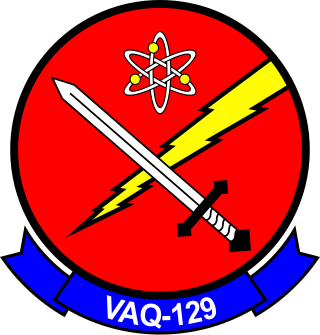
Electronic Attack Squadron 129 (VAQ-129) is the United States Navy's only EA-18G Growler training squadron. Known as the "Vikings", they are a Fleet Replacement Squadron, or FRS, and are charged with training all EA-18G aviators and developing standard operating procedures for the maintenance and operation of the aircraft. The squadron is permanently stationed at Naval Air Station Whidbey Island, in Puget Sound, Washington.
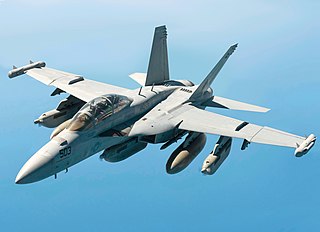
The Boeing EA-18G Growler is an American carrier-based electronic warfare aircraft, a specialized version of the two-seat Boeing F/A-18F Super Hornet. The EA-18G replaced the Northrop Grumman EA-6B Prowlers in service with the United States Navy. The Growler's electronic warfare capability is primarily provided by Northrop Grumman. The EA-18G began production in 2007 and entered operational service with the US Navy in late 2009. Australia has also purchased thirteen EA-18Gs, which entered service with the Royal Australian Air Force in 2017.

Electronic Attack Squadron 135 (VAQ-135), known as the "Black Ravens", is a United States Navy electronic attack squadron that currently operates the EA-18G Growler carrier-based electronic warfare jet aircraft. The squadron is permanently stationed at Naval Air Station Whidbey Island with a radio callsign of "Thunder".

Electromagnetic Attack Squadron ONE FOUR ZERO (VAQ-140) is a US Navy electromagnetic attack squadron. Known as the "Patriots", the squadron operates the EA-18G Growler. The squadron is home ported at NAS Whidbey Island, Washington. They are attached to Carrier Air Wing Seven, and deploy aboard USS George H W Bush. The squadron's radio callsign is "Talon" and are formally recognized as America's Squadron. Their aircrew commonly reference the rallying cry of "Glizzy Roll" in honor of their traditional ready room hot dog roller. Their mascot is their newest aircrew dressing as Evel Knievel.

Electromagnetic Attack Squadron 137 (VAQ-137) also known as the "Rooks", is a United States Navy electromagnetic attack squadron based at Naval Air Station Whidbey Island Washington, flying the Boeing EA-18G Growler. The squadron is attached to Carrier Air Wing 11 (CVW-11), which is currently assigned to USS Theodore Roosevelt (CVN-71). Their radio callsign is "Rook" and their tailcode is "NH" of CVW-11.
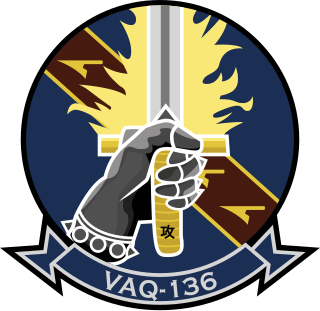
Electronic Attack Squadron 136 (VAQ-136) "Gauntlets" is a United States Navy Electronic attack squadron flying the EA-18G Growler and is currently attached to Carrier Air Wing Two, deploy aboard the aircraft carrier USS Carl Vinson a composite unit made up of a wide array of aircraft performing a variety of combat and support missions including F2T2EA. The squadron is currently stationed at Naval Air Station Whidbey Island.
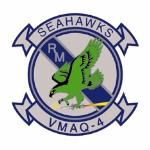
Marine Tactical Electronic Warfare Squadron 4 (VMAQ-4) was a United States Marine Corps electronic warfare squadron consisting of EA-6B Prowler jets. The squadron was last based at Marine Corps Air Station Cherry Point, North Carolina and fell under the command of Marine Aircraft Group 14 (MAG-14), and the 2nd Marine Aircraft Wing. The squadron was decommissioned on 2 June 2017 as the Marine Corps sundowns the EA-6B Prowler.

Electromagnetic Attack Squadron 142 (VAQ-142), also known as "The Gray Wolves", is an EA-18G Growler squadron of the United States Navy stationed at Naval Air Station Whidbey Island, Oak Harbor, Washington. Their tailcode is AJ and their ATC callsign is "GRIM".
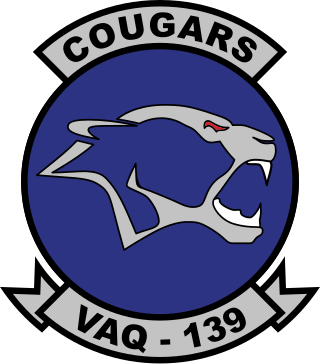
Electromagnetic Attack Squadron 139 (VAQ-139), also known as the "Cougars", is an EA-18G Growler squadron of the United States Navy. They specialize in electromagnetic attack and are currently stationed at Naval Air Station Whidbey Island, Washington. Part of Carrier Air Wing Seventeen, the Cougars deploy aboard the aircraft carrier USS Nimitz

The 390th Electronic Combat Squadron is a United States Air Force unit. It is assigned to the 366th Fighter Wing at Mountain Home Air Force Base, Idaho and stationed at Naval Air Station Whidbey Island, Washington.

Electronic Attack Squadron 130 (VAQ-130), also known as the "Zappers", is an EA-18G Growler squadron of the United States Navy based aboard Naval Air Station Whidbey Island. Part of Carrier Air Wing 3, the Zappers deploy aboard the aircraft carrier USS Dwight D. Eisenhower. VAQ-130 is the oldest electronic warfare squadron in the U.S. Navy.

Electromagnetic Attack Squadron 133 (VAQ-133) is an EA-18G Growler squadron of the United States Navy based at Naval Air Station Whidbey Island, Washington. Beginning in 2013, the squadron began the transition from the EA-6B to the EA-18G. Upon completion of the transition in spring of 2014, they returned to their attachment to Carrier Air Wing Nine. The squadron's nickname is "Wizards" and its radio callsign is "Magic".

Electromagnetic Attack Squadron 131 (VAQ-131), also known as the "Lancers," is a United States Navy tactical jet aircraft squadron specializing in kinetic and non-kinetic Suppression of Enemy Air Defenses (SEAD). They are based at Naval Air Station Whidbey Island, flying the EA-18G Growler. Their radio callsign is "Skybolt."

Electromagnetic Attack Squadron 132 (VAQ-132), the "Scorpions", is a United States Navy aircraft squadron based at Naval Air Station Whidbey Island, flying the EA-18G Growler. The squadron's radio callsign is "Scorp".

Electronic Attack Squadron 134 (VAQ-134) is an electromagnetic warfare squadron of the United States Navy. It is nicknamed "Garudas" and is based at Naval Air Station Whidbey Island, Washington. The squadron is currently equipped with the Boeing EA-18G Growler.
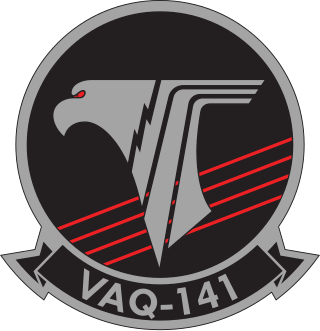
Electromagnetic Attack Squadron 141 (VAQ-141), also known as the "Shadowhawks", is an EA-18G Growler squadron of the United States Navy that is based at Marine Corps Air Station Iwakuni, located in Iwakuni, Yamaguchi, Japan. VAQ-141 falls under the cognizance of Commander, Electromagnetic Attack Wing Pacific (COMVAQWINGPAC) and flies in support of Carrier Air Wing 5 (CVW-5) aboard the Nimitz-class aircraft carrier, USS Ronald Reagan (CVN-76).

Electronic Attack Squadron 138 (VAQ-138), also known as the "Yellow Jackets", is an expeditionary EA-18G Growler squadron of the United States Navy based at Naval Air Station Whidbey Island, Washington.

























